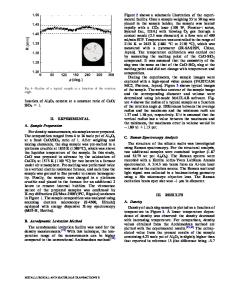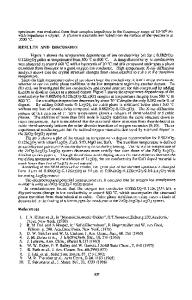Effect of Ce 2 O 3 on Structure, Viscosity, and Crystalline Phase of CaO-Al 2 O 3 -Li 2 O-Ce 2 O 3 Slags
- PDF / 1,654,125 Bytes
- 6 Pages / 593.972 x 792 pts Page_size
- 59 Downloads / 402 Views
s steel has found profound usage in various fields due to its high strength and excellent corrosion resistance property. With significant technical innovations, industries such as aerospace, marine, chemical, and petroleum have made increasing and stricter demand on stainless steel properties, which some conventional grade of stainless steel could not provide.[1,2] Study shows that rare earths such as cerium have considerable effects on micro-alloying and improving performance of the steel.[3,4] For example, addition of misch metal in duplex stainless steels led to an increase in the resistance to pitting corrosion.[5,6] Ce could form a thermodynamically stable surface film composed of CeOx, which improves the resistance to pitting, crevice, and intergranular corrosions.[7,8] Thus, cerium has been intensively used in the process of stainless steel
JIE QI, Doctoral Candidate, CHENGJUN LIU and MAOFA JIANG, Professors, and CHI ZHANG, Master Degree Candidate, are with the Key Laboratory for Ecological Metallurgy of Multimetallic Ores (Ministry of Education), Northeastern University, Shenyang 110819, Liaoning, P.R. China, and also with the School of Metallurgy, Northeastern University, Shenyang 110819, Liaoning, P.R. China. Contact e-mail: [email protected] Manuscript submitted June 16, 2016. METALLURGICAL AND MATERIALS TRANSACTIONS B
production. However, in order to obtain a critical property, required addition amount of Ce is beyond industry process limit. For example, the addition of Ce is above 0.1 wt pct in some Ce-bearing austenitic stainless steels,[9] the amount of Ce in some DSS is up to 0.067 wt pct,[6] and the desired content of Ce is about 0.03 to 0.08 wt pct in heat-resistant steel such as 253MA.[10] The molten Ce-bearing stainless steel has strong reducibility because the content of cerium is high. Hence, severe slag-metal interface reactions were induced in the mold when conventional mold fluxes were used. Severe slag-metal interface reactions could lead to surface defects formation and serious sticking breakout.[11] In order to restrain the slag-metal interface reactions in the mold, different new mold fluxes containing cerium oxide based on calcium aluminates system have been devised in our previous works.[12,13] There are reports on research work focusing on the CaO-Al2O3-based slags or the low-silica calcium aluminate slags. Structure of CaO-Al2O3 and CaO-Al2O3CaF2 slags has been measured via Fourier transform infrared spectra by Park et al.[14] Kim et al.[15] has investigated the structure-viscosity relationship of CaO-Al2O3-SiO2-MgO-CaF2 (SiO2 £ 10 wt pct) melts, and the influence of CaF2 on the structure-property relationship was explored. Moreover, Wen et al.,[16] Wang et al.,[17] Shi et al.,[18] and Cho et al.[19] also did amounts of work on design and properties investigation of different CaO-Al2O3-based slags. However, most of those studies have been generally limited either to slag systems without rare earth oxides or the CaO-SiO2based melts.[20,21] Yet, with regard to Ce2O3 in aluminate-based slags
Data Loading...











